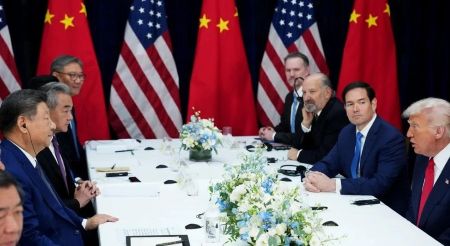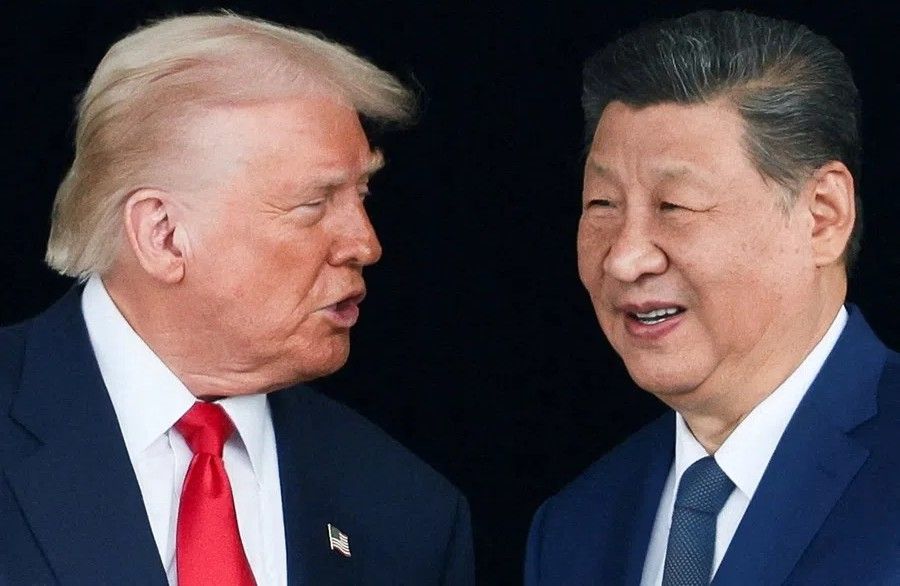The much-awaited meeting between US President Donald Trump and Chinese President Xi Jinping finally took place last week in Busan, South Korea. Reportedly, the two adversaries reached a wide-ranging trade and economic agreement during the meeting. The deal addresses fentanyl precursors, rare earth export controls, tariffs, and semiconductor trade restrictions — signalling a possible stabilisation in US–China ties.
THE BUSAN MEETING between President Trump and his Chinese counterpart Xi Jinping took place after a gap of six years, though, as President Xi pointed out, they had spoken over the phone thrice during this period. The meeting was expected to address several tricky issues between the world’s two largest economies.
While one side sought to hammer out an agreement through the threat of brute economic power, the other acted more subtly, assured of its position as the global manufacturing hub.

Trump and Xi during their Busan summit, aiming to ease trade tensions
Overall, the summit could be described as largely optical for the American public, as it may not translate into any tangible gain for the American taxpayer. Further, Trump’s proposed visit to China may not materialise due to other emerging issues muddying the atmosphere.
Relations between the two world powers have been strained in recent years, with Washington and Beijing imposing tit-for-tat trade tariffs of over 100 percent earlier this year.
The US has restricted exports of semiconductors vital for artificial intelligence (AI) development, while Beijing has imposed curbs on the export of critical rare-earth metals essential for the defence and AI industries, among other sectors.
Officials from Washington and Beijing had been engaged in trade talks since August to de-escalate tensions. They reportedly agreed on a framework for a trade deal during meetings in Malaysia over the weekend, though how much of it was implemented in reality remains unclear.
On the sidelines of the Asia-Pacific Economic Cooperation (APEC) summit in Gyeongju, South Korea, Trump said that the expected trade deal between China and the US would be good for both countries and “something very exciting for everybody.”
The discussions were expected to cover trade tariffs, including fentanyl trafficking — the drug responsible for tens of thousands of deaths in the US each year — China’s export controls on critical rare-earth metals, its purchase of US soybeans, and the US export controls on semiconductors.

US–China trade talks remain tense despite promises of de-escalation
Among the geopolitical and security issues discussed were the ongoing Russia–Ukraine war, Washington’s position on Taiwan, port fees on Chinese ships docking in US ports, and the finalisation of a deal to buy TikTok from its Chinese owners.
The meeting was also intended to ease the ongoing uneasy trade spat between the two nations. Washington wanted to demonstrate that its tough stance on China had yielded results, while Beijing aimed to project calm and resilience. Xi Jinping also wanted to show that, despite Western pressure, China remained focused on economic growth and domestic stability.
Contrary to popular assumption, the tensions between the two nations did not originate during Trump 2.0 but were actually initiated by Trump in 2018. Former President Joe Biden later tightened restrictions on US semiconductor exports — crucial for AI development — much to China’s annoyance. Then, earlier this year, Trump compounded matters by imposing 145 percent tariffs on Chinese goods.

Escalating tariffs have strained US–China trade relations since 2018
China retaliated with 125 percent tariffs on US goods, escalating the trade war, until both sides agreed in May to pause further tariff actions to allow for negotiations. However, before that, China had imposed export restrictions on seven rare-earth metals in April, followed by curbs on five more in October. Trump responded by threatening 100 percent tariffs once again.
In October, Trump announced he would impose the 100 percent tariffs from November 1, citing Beijing’s strict export controls on critical rare earths as justification. He also declared that the US would restrict exports of “any and all critical software.”
Further, Washington blacklisted hundreds of Chinese tech firms, alleging they posed national security risks. The US also restricted companies such as Nvidia from exporting advanced chips — essential for manufacturing AI development tools — to China, claiming that Beijing would use them to enhance its global dominance.
Beijing, angered by these restrictions, launched antitrust investigations into Nvidia and Qualcomm and tightened its own export controls on rare-earth elements. Meanwhile, both countries have accused each other of economic coercion that is destabilising the global economy.

Trump meets Xi Jinping for first time in 6 years, calls him ‘great leader’
President Trump declared victory soon after meeting Xi Jinping, claiming he had offered to reduce tariffs on Chinese goods by ten percentage points — bringing overall tariffs down from 57 percent to 47 percent.
However, the details emerging after the summit suggest it was merely a lull before the next storm. According to Trump, China agreed to postpone implementation of its rare-earth export controls for one year.
Yet, experts point out that it would take the US at least ten years to reduce its dependence on Chinese rare earths. Beijing also offered to buy millions of tons of soybeans from the United States and to control fentanyl exports.

Despite the Busan summit, key issues like Taiwan and AI technology remain unresolved
Notably, there was no mention of the crucial Taiwan issue during the summit. Trump also failed to secure China’s agreement to stop buying Russian oil — a major setback to his stated goal of ending the Ukraine war.
Strangely, just before the summit, Trump announced on his social media platform that he had instructed his Department of War to resume nuclear testing.
Soon after the summit, China advised the Trump Administration to adhere to the moratorium on nuclear testing agreed upon under the CTBT. The timing of this announcement baffled analysts and underscored Trump’s failure to secure any Chinese cooperation on nuclear arms control.
Overall, China appears to have emerged as the winner after the summit, as the actual implementation of the agreements may never materialise. Moreover, Trump’s nuclear testing announcement could create fresh tensions in the near future — an alarming development that may push the world closer to a new era of instability. ![]()
_________
Also Read:
Disclaimer : PunjabTodayNews.com and other platforms of the Punjab Today group strive to include views and opinions from across the entire spectrum, but by no means do we agree with everything we publish. Our efforts and editorial choices consistently underscore our authors’ right to the freedom of speech. However, it should be clear to all readers that individual authors are responsible for the information, ideas or opinions in their articles, and very often, these do not reflect the views of PunjabTodayNews.com or other platforms of the group. Punjab Today does not assume any responsibility or liability for the views of authors whose work appears here.
Punjab Today believes in serious, engaging, narrative journalism at a time when mainstream media houses seem to have given up on long-form writing and news television has blurred or altogether erased the lines between news and slapstick entertainment. We at Punjab Today believe that readers such as yourself appreciate cerebral journalism, and would like you to hold us against the best international industry standards. Brickbats are welcome even more than bouquets, though an occasional pat on the back is always encouraging. Good journalism can be a lifeline in these uncertain times worldwide. You can support us in myriad ways. To begin with, by spreading word about us and forwarding this reportage. Stay engaged.
— Team PT

